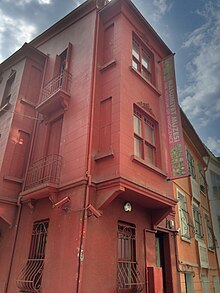Çukurcuma

Çukurcuma ( pronounced Tschukúrdschumaa, German "Freitagssenke") is a European neighborhood district (Semt) in Istanbul's Beyoğlu district (the historic Pera ), which is characterized by a variety of antique shops and cafes. Most of the buildings date from the 19th and early 20th centuries, with a few Ottoman buildings dating back to the 15th century.
location
Administratively it lies in the districts ("Mahalleler") Kuloğlu and Firuzağa . It is located southeast of İstiklal Caddesi on a valley basin overlooking the Bosphorus , southeast of Galatasaray Square and between the Tomtom and Cihangir districts . The Çukurcuma Caddesi runs through the area.
history
The area of today's quarter remained uninhabited in Byzantine times. During the conquest of Constantinople (1453) Sultan Mehmed II the conqueror is said to have initiated a Friday prayer in the valley . The Turkish words "çukur" for sink (actually pit) and "cuma" for Friday led to the name "Çukurcuma", which is still used today. The Muhiddin-Molla-Fenari-Mosque could also be traced back to Mehmed. The current wooden structure was built between 1541 and 1547 under the architect Mimar Sinan on behalf of Sheikh al-Islam Çivizade Hacı Mehmed Efendi .
Mehmed II used the area for hunting even after the conquest, and there is evidence that a hunting lodge with a Turkish bath was built here in 1454 , which is still used today as " Ağa hamamı " and is considered the oldest in Istanbul.
The water distribution system ( Taksim ) above Çukurcuma, built in 1732 by order of Sultan Mahmud I , also supplied this area with a water pipe that is believed to have connected the Ağa hamamı. Opposite the neighborhood mosque is the Ömer Ağa Fountain, which was built in 1720.
In the 19th century extended from the Istiklal -Prachtstraße Peras the development with civil, founder time stamped houses even after Çukurcuma. In addition to ethnic Turks, not only Armenians and Greeks lived in the quarter, but also Europeans in old Pera, who set up schools, hospitals and diplomatic missions here and in the neighboring quarters. The Liceo Italiano “Galileo Galilei” has been located in the quarter since 1882, along with the Greek Zoğrafyon grammar school and the building of the Greek Consulate General . The 1955 pogrom in Istanbul hit the district accordingly. Almost all Turkish Greeks and many Armenians emigrated as a result.
The neighborhood today
As a result, the district has retained a certain multicultural European character and is known for its antique shops and cafes and is sometimes referred to as the bohemian district. The electorate, unlike the majority in Beyoğlu District, is CHP -oriented. In 2008, the Nobel laureate in literature Orhan Pamuk published his novel The Museum of Innocence , which is set in Çukurcuma. In 2012, Pamuk opened the museum of the same name in the district, designed by the German architects Sunder-Plassmann. In 2014 the museum was named European Museum of the Year . In 2008 the New York Times described Çukurcuma as a cozy, intimate Grand Bazaar . In the same year the British newspaper The Guardian devoted itself to the district. In 2012 she ranked Çukurcuma among the five best places to live in the world.
Web links
literature
- Brendan Freely , John Freely : Galata, Pera, Beyoğlu: A biography . Yapı Kredi Yayınları, İstanbul 2016, ISBN 978-975-08-3589-6 , p. 250 f . (274 pp.).
Individual evidence
- ↑ madebycat.com: Istanbul's Bohemian Quarter: Çukurcuma. Accessed January 30, 2020 (English).
- ↑ Oldest Turkish Bath in Istanbul | Aga Hamami. Accessed January 30, 2020 .
- ↑ madebycat.com: Istanbul's Bohemian Quarter: Çukurcuma. Accessed January 30, 2020 (English).
- ↑ European Museum of the Year Award 2014. June 9, 2014, accessed January 30, 2020 .
- ↑ Yigal Grinder: A More Intimate Grand Bazaar . In: The New York Times . February 10, 2008, ISSN 0362-4331 ( nytimes.com [accessed February 1, 2020]).
- ↑ Benji Lanyado: Streets ahead: Cukurcuma in Istanbul . In: The Guardian . September 12, 2008, ISSN 0261-3077 ( theguardian.com [accessed January 30, 2020]).
- ^ Tom Dyckhoff: The five best places to live in the world, and why . In: The Guardian . January 20, 2012, ISSN 0261-3077 ( theguardian.com [accessed January 30, 2020]).
